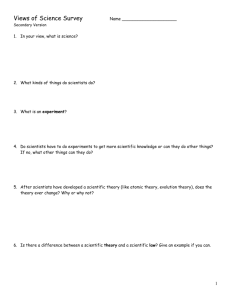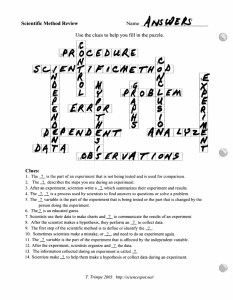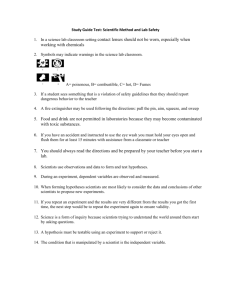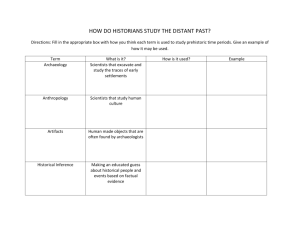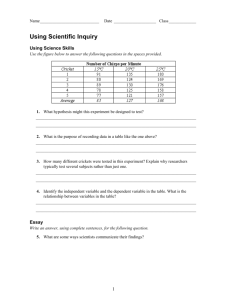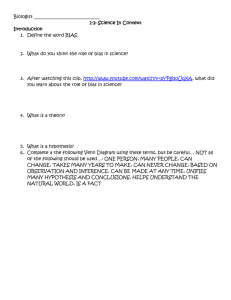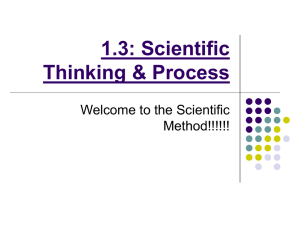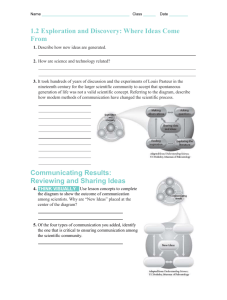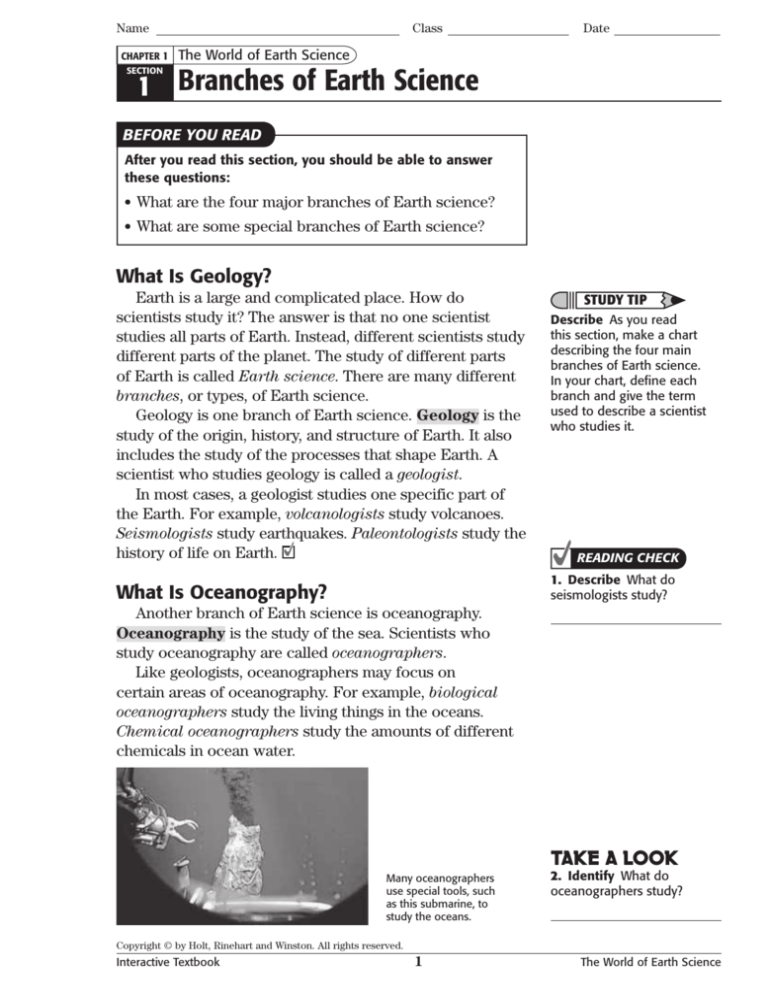
Name
CHAPTER 1
Class
Date
The World of Earth Science
SECTION
1 Branches of Earth Science
BEFORE YOU READ
After you read this section, you should be able to answer
these questions:
• What are the four major branches of Earth science?
• What are some special branches of Earth science?
What Is Geology?
Earth is a large and complicated place. How do
scientists study it? The answer is that no one scientist
studies all parts of Earth. Instead, different scientists study
different parts of the planet. The study of different parts
of Earth is called Earth science. There are many different
branches, or types, of Earth science.
Geology is one branch of Earth science. Geology is the
study of the origin, history, and structure of Earth. It also
includes the study of the processes that shape Earth. A
scientist who studies geology is called a geologist.
In most cases, a geologist studies one specific part of
the Earth. For example, volcanologists study volcanoes.
Seismologists study earthquakes. Paleontologists study the
history of life on Earth.
STUDY TIP
Describe As you read
this section, make a chart
describing the four main
branches of Earth science.
In your chart, define each
branch and give the term
used to describe a scientist
who studies it.
READING CHECK
1. Describe What do
seismologists study?
What Is Oceanography?
Another branch of Earth science is oceanography.
Oceanography is the study of the sea. Scientists who
study oceanography are called oceanographers.
Like geologists, oceanographers may focus on
certain areas of oceanography. For example, biological
oceanographers study the living things in the oceans.
Chemical oceanographers study the amounts of different
chemicals in ocean water.
TAKE A LOOK
Many oceanographers
use special tools, such
as this submarine, to
study the oceans.
2. Identify What do
oceanographers study?
Copyright © by Holt, Rinehart and Winston. All rights reserved.
Interactive Textbook
1
The World of Earth Science
Name
SECTION 1
Class
Date
Branches of Earth Science continued
What Is Meteorology?
READING CHECK
3. Define What is
meteorology?
Meteorology is a branch of Earth science that
deals with Earth’s atmosphere, especially weather and
climate. Scientists who study meteorology are called
meteorologists.
Many meteorologists try to forecast, or predict, the
weather. In most cases, weather forecasts help to make our
lives more comfortable. Sometimes, meteorologists can
help save people’s lives by predicting severe weather, such
as hurricanes and tornadoes. These predictions can warn
people to leave an area before severe weather strikes.
TAKE A LOOK
4. Explain How can
meteorology save people’s
lives?
These meteorologists are risking their
lives to gather information about
tornadoes. This information may help
other meteorologists better predict
where and when tornadoes will strike.
What Is Astronomy?
Critical Thinking
5. Compare What is the
main difference between
astronomy and other
branches of Earth science?
Astronomy is the study of the universe. Astronomers
are scientists who study stars, asteroids, planets, and other
objects in space.
Most objects in space are very far away. Therefore,
astronomers depend on technology to help them study
these objects. For example, astronomers may use
telescopes to study distant stars and planets.
You may wonder why astronomy is a branch of Earth
science if astronomers study objects far from the Earth.
The reason is that many astronomers use information
about other planets and stars to learn more about the
Earth. For example, some astronomers study ancient stars
in the universe. The information they gather can help them
to predict how changes in our sun may affect the Earth.
Copyright © by Holt, Rinehart and Winston. All rights reserved.
Interactive Textbook
2
The World of Earth Science
Name
SECTION 1
Class
Date
Branches of Earth Science continued
What Are Some Other Branches of Earth
Science?
Geology, oceanography, meteorology, and astronomy
are the four main branches of Earth science. However,
there are many other branches of Earth science.
ENVIRONMENTAL SCIENCE
Environmental science is the study of how humans
interact with the environment. Environmental scientists
help people learn ways to preserve the environment and to
use resources wisely.
ECOLOGY
Ecology is the study of relationships between
living things and their environments. Ecologists study
communities of organisms and their environments to
better understand how organisms behave. Ecologists work
in many fields, including agriculture and forestry.
GEOCHEMISTRY
Geochemistry combines the studies of geology and
chemistry. Geochemists study the chemicals that make
up Earth materials such as rocks, minerals, and soil. They
can use this information to learn how the Earth materials
formed. Geochemists may also study the effects of humanmade chemicals on the environment.
READING CHECK
6. Identify Give two things
that environmental scientists
can help people learn to do.
Say It
Discuss In a small group,
talk about different jobs that
Earth scientists can have.
Who may Earth scientists
work for? What kinds of work
could they do every day?
TAKE A LOOK
Geochemists may
take rock samples
and analyze them
in a laboratory.
7. Describe What do
geochemists study?
GEOGRAPHY AND CARTOGRAPHY
Geography is the study of the surface features of
the Earth, such as continents, rivers, and mountains.
Many geographers work in cartography, or map-making.
Cartographers use information from photographs and
computers to make maps. They may also study the ways
that areas change with time.
Copyright © by Holt, Rinehart and Winston. All rights reserved.
Interactive Textbook
3
The World of Earth Science
Name
Class
Date
Section 1 Review
SECTION VOCABULARY
astronomy the scientific study of the universe
geology the scientific study of the origin, history,
and structure of Earth and the processes that
shape Earth
meteorology the scientific study of Earth’s
atmosphere, especially in relation to weather
and climate
oceanography the scientific study of the ocean,
including the properties and movements of
ocean water, the characteristics of the ocean
floor, and the organisms that live in the ocean
1. List What are the four major branches of Earth science?
2. Infer What kind of Earth scientist would most likely study thunderstorms?
Explain your answer.
3. Explain Why is astronomy a branch of Earth science?
4. Compare How is environmental science different from ecology?
5. Explain Why do astronomers depend on technology?
6. Define What is geography?
Copyright © by Holt, Rinehart and Winston. All rights reserved.
Interactive Textbook
4
The World of Earth Science
Name
CHAPTER 1
Class
Date
The World of Earth Science
SECTION
2 Scientific Methods in Earth Science
BEFORE YOU READ
After you read this section, you should be able to answer
these questions:
• What are the steps used in scientific methods?
• How is a hypothesis tested?
• Why do scientists share their findings with others?
How Do Scientists Learn About the World?
Imagine you are standing in a thick forest. Suddenly,
you hear a booming noise, and you feel the ground shake.
You notice a creature’s head looming over the treetops.
The creature’s head is so high that its neck must be
20 m long! Then, the whole animal comes into view. Now
you know why the ground is shaking. The giant animal is
Seismosaurus hallorum, the “earthquake lizard.”
This description of Seismosaurus hallorum is not just
from someone’s imagination. Since the 1800s, scientists
have gathered information about dinosaurs and their
environment. Using this knowledge, scientists can infer
what dinosaurs may have been like hundreds of millions of
years ago.
How do scientists piece all the information together?
How do they know if they have discovered a new species
of dinosaur? Asking these questions is the first step in
using scientific methods to learn more about the world.
STUDY TIP
Outline As you read this
section, make a chart
showing the ways that David
Gillette used the steps in
scientific methods to learn
more about the dinosaur
bones he studied.
Seismosaurus hallorum
was one of the largest
dinosaurs that ever lived.
Math Focus
1. Make Comparisons
When a Seismosaurus held
its head up as high as it
could, it could have been
25 m tall. What fraction of
Seismosaurus’s height is your
height? Give your answer as
a decimal.
Copyright © by Holt, Rinehart and Winston. All rights reserved.
Interactive Textbook
5
The World of Earth Science
Name
SECTION 2
Class
Date
Scientific Methods in Earth Science continued
What Are Scientific Methods?
READING CHECK
2. Define What are scientific
methods?
Scientific methods are a series of steps that scientists
use to answer questions and to solve problems. Although
each question is different, scientists can use the same
methods to find answers.
Scientific methods have several steps. Scientists may
use all of the steps or just some of them. They may even
repeat some of the steps.
The goal of scientific methods is to come up with reliable
answers and solutions. These answers and solutions must
be able to stand up to the testing of other scientists.
TAKE A LOOK
3. Use Models Starting
with “Ask a question,” trace
two different paths through
the figure to “Communicate
results.” Use a colored pen or
marker to trace your paths.
There are many steps in scientific methods. Notice that there are many ways to
move through the different steps.
Why Is It Important to Ask a Question?
Asking a question helps scientists focus on the most
important things they want to learn. The question helps to
guide the research that the scientist does.
David D. Gillette is a scientist who studies fossils. In
1979, he began to study some fossil bones from New
Mexico. He knew they came from a dinosaur, but he did
not know which kind.
Gillette began his study by asking, “What kind of
dinosaur did these bones come from?” We will use a table
to follow Gillette as he tried to answer his question using
scientific methods.
Step in scientific methods
How did David Gillette apply this step?
Asking questions
He wondered what kind of dinosaur the
bones came from.
Copyright © by Holt, Rinehart and Winston. All rights reserved.
Interactive Textbook
6
The World of Earth Science
Name
SECTION 2
Class
Date
Scientific Methods in Earth Science continued
How Do Scientists Form a Hypothesis?
When scientists want to investigate a question, they
form a hypothesis. A hypothesis (plural, hypotheses) is
a possible answer to a question. It is sometimes called an
educated guess.
The hypothesis is a scientist’s best answer to the
question. However, a scientist can’t just assume that a
hypothesis is the correct answer. The scientists must test
the hypothesis to see if it is true.
From his observations and knowledge about dinosaurs,
Gillette formed a hypothesis about the bones. He thought
that the bones came from a kind of dinosaur that had not
been discovered yet. To test his hypothesis, Gillette had to
do a lot of research.
Step in scientific methods
How did David Gillette apply this step?
READING CHECK
4. Define What is a
hypothesis?
TAKE A LOOK
5. Identify Fill in the blank
spot in the table with David
Gillette’s hypothesis.
Forming a hypothesis
How Do Scientists Test a Hypothesis?
To see if an idea can be proven scientifically, scientists
must test the hypothesis. They do this by gathering data.
Data (singular, datum) are pieces of information gathered
through observation or experimentation. Scientists use
data to learn if their hypotheses are correct.
READING CHECK
6. Define What are data?
TESTING WITH EXPERIMENTS
To test a hypothesis, a scientist may perform a
controlled experiment. A controlled experiment tests
only one factor, or variable, at a time. No other variables
change. By changing only one variable, scientists can see
the results of changing just one thing.
For example, suppose a scientist does an experiment
to learn the temperature that a rock melts at. The scientist
uses several samples of the same kind of rock. She heats
each sample to a different temperature and records
whether the rock melts. The type of rock does not change,
but the temperature does. Therefore, temperature is the
variable.
Copyright © by Holt, Rinehart and Winston. All rights reserved.
Interactive Textbook
7
The World of Earth Science
Name
SECTION 2
Class
Date
Scientific Methods in Earth Science continued
KEEPING ACCURATE RECORDS
During experiments, scientists must keep accurate
records of everything that they do and observe. This
includes failed attempts, too. Keeping detailed records
helps scientists to show that their results are accurate.
Accurate records can also help other scientists to repeat
an experiment.
Critical Thinking
7. Compare and Contrast
What is the difference
between a controlled
experiment and observation?
TESTING WITHOUT EXPERIMENTS
Sometimes, it is not possible to do a controlled
experiment. In such cases, scientists depend on
observation to test their hypotheses. By observing nature,
scientists can collect large amounts of data. If the data
support a hypothesis, the hypothesis is probably correct.
To test his hypothesis, Gillette took hundreds of
measurements of bones. He also visited museums and
talked with other scientists.
To test his hypothesis, Gillette took hundreds
of measurements of the sizes and shapes of
the bones.
TAKE A LOOK
8. Identify In the table, fill
in the way that David Gillette
tested his hypothesis.
Step in scientific methods
How did David Gillette apply this step?
Testing hypotheses
How Do Scientists Analyze Results?
READING CHECK
9. Explain Why do scientists
analyze their data?
When scientists finish collecting data, they must analyze
the results. Analyzing results helps scientists explain
their observations. Their explanations are based on the
evidence they collect.
To arrange their data, scientists often make tables and
graphs. Gillette organized his data in a table that compared
the sizes and shapes of his dinosaur bones. He compared
his measurements to measurements of bones from known
dinosaurs. When he analyzed his results, he found that the
mystery dinosaur’s bones did not match the bones of any
known dinosaur.
Copyright © by Holt, Rinehart and Winston. All rights reserved.
Interactive Textbook
8
The World of Earth Science
Name
SECTION 2
Class
Date
Scientific Methods in Earth Science continued
Step in scientific methods
How did David Gillette apply this step?
TAKE A LOOK
10. Identify In the table, fill
in the way that David Gillette
analyzed his results.
Analyzing results
What Are Conclusions?
After analyzing results, a scientist must decide if the
results agree with, or support, the hypotheses. This is
called drawing conclusions. Finding out that a hypothesis
is not true can be as valuable as finding out that a
hypothesis is true.
Sometimes, the results do not support the hypothesis.
When this happens, scientists may repeat the investigation
to check for mistakes. Scientists may repeat experiments
hundreds of times. Another option is to ask another
question and make a new hypothesis.
From all his work, Gillette concluded that the bones
found in New Mexico were from an unknown dinosaur.
From his data, he learned that the new dinosaur was
about 35 m long and had a mass of 30 to 70 metric tons.
The dinosaur definitely fits the name Gillette gave it—
Seismosaurus hallorum, or the “earthquake lizard.”
Step in scientific methods
How did David Gillette apply this step?
Critical Thinking
11. Infer How can finding
out that a hypothesis is not
true be useful for a scientist?
TAKE A LOOK
12. Identify In the table, fill
in David Gillette’s conclusions
about his dinosaur bones.
Drawing Conclusions
Why Do Scientists Share Their Findings?
After finishing a study, scientists share their results with
others. They write reports and give presentations. They
can also put their results on the Internet.
Sharing information gives other scientists the chance to
repeat the experiments for themselves. If other scientists
get different results, more studies must be done to find out
if the differences are important.
In many cases, the results of an investigation are
reviewed year after year as new evidence is found. In the
case of Seismosaurus, the debate still continues. Some
scientists think that Seismosaurus is a new genus of
dinosaur. Other scientists think that it belongs to the genus
Diplodocus. As scientists gather more data on the fossil
bones, they may change their conclusions.
READING CHECK
13. Describe Why is it
important for scientists to
share their results?
Copyright © by Holt, Rinehart and Winston. All rights reserved.
Interactive Textbook
9
The World of Earth Science
Name
Class
Date
Section 2 Review
SECTION VOCABULARY
hypothesis a testable idea or explanation that
leads to scientific investigation
scientific methods a series of steps followed to
solve problems
1. Describe How can a scientist test a hypothesis if it is not possible to do a
controlled experiment?
2. Explain Why is it important for scientists to ask questions?
3. Apply Procedures You observe that your tongue sticks to a very cold ice pop when
you lick it. You ask yourself, “Why does my tongue stick to the ice pop?” Make a
hypothesis about why your tongue sticks to the ice pop.
4. Identify How could you share the results of an experiment with the rest of your
class? Give three ways.
5. Infer Why might a scientist need to repeat a step in scientific methods?
Copyright © by Holt, Rinehart and Winston. All rights reserved.
Interactive Textbook
10
The World of Earth Science
Name
CHAPTER 1
Class
Date
The World of Earth Science
SECTION
3 Scientific Models
BEFORE YOU READ
After you read this section, you should be able to answer
these questions:
• How do scientists use models?
• What are three kinds of scientific models?
What Are Models?
Why do scientists use crash-test dummies to learn how
safe cars are? By using crash-test dummies, scientists can
learn how to make cars safer without putting real people
in danger. A crash-test dummy is a model of a person. A
model is something scientists use to represent an object
or event in order to make it easier to study.
Scientists use models to study things that are very
small, like atoms, or things that are very large, like Earth.
Some scientists use models to predict things that haven’t
happened yet, or to study events that happened long ago.
Some models, like crash-test dummies, allow scientists to
study events without affecting or harming the things they
are studying.
Models are very useful for scientists. However, you
cannot learn everything by studying a model, because
models are not exactly like the objects they represent.
STUDY TIP
Compare As you read, make
a table to show the features
of physical models and
mathematical models.
READING CHECK
1. Identify Give two reasons
scientists use models.
PHYSICAL MODELS
Physical models are models that you can see or touch.
Many physical models look like the things they represent.
Other physical models may look different from the things
they represent. For example, a map is a physical model of
Earth. However, a flat map looks very different from the
round Earth!
READING CHECK
2. Define What is a physical
model?
A globe is a physical model of the Earth.
Copyright © by Holt, Rinehart and Winston. All rights reserved.
Interactive Textbook
11
The World of Earth Science
Name
SECTION 3
Class
Date
Scientific Models continued
MATHEMATICAL MODELS
READING CHECK
3. Define What is a
mathematical model?
READING CHECK
4. Explain Why do scientists
use computers to process
many mathematical models?
A mathematical model is made up of data and
mathematical equations. A mathematical equation shows
how data are related to each other. Some mathematical
models are simple. They can help you calculate things
such as how far a car will travel in an hour. Other models
are more complicated. These models can contain a lot of
data related by complicated equations.
Meteorologists often use mathematical models called
climate models to help them study the Earth’s climate.
Most climate models include large amounts of data. The
data may be measurements of temperatures or amounts of
rainfall.
Climate models use equations to represent different
parts of Earth’s climate. For example, some equations
represent the way that ocean water moves. Others
represent the way that the amount of carbon dioxide in the
air changes with time.
You may wonder how scientists can use models that
contain so many data and equations. Scientists use
computers to help them process these complicated
models. Because computers can deal with large amounts
of data, they can solve many mathematical problems at
once. Computers can do complicated calculations more
quickly and accurately than people can.
Climate models, like most mathematical models, do not
make exact predictions. Instead, they estimate what may
happen. Scientists and lawmakers can use the estimates to
help them plan for the future.
TAKE A LOOK
5. Identify What are two
kinds of data that may be
part of a climate model?
The climate model in this picture was produced by a computer. The computer
combined huge amounts of data and equations into the climate model. Without
computers, scientists would not be able to use complicated models like this.
Copyright © by Holt, Rinehart and Winston. All rights reserved.
Interactive Textbook
12
The World of Earth Science
Name
Class
Date
Scientific Models continued
SECTION 3
CONCEPTUAL MODELS
A conceptual model is a diagram, drawing, or spoken
description of how something works or is put together.
Conceptual models may be made of many different
hypotheses. Each hypothesis is supported by scientific
methods. For example, the conceptual model below shows
how mercury moves through the environment. Scientists
have used scientific methods to learn how mercury from
coal burning can affect humans.
Mercury released into the air from burning coal
Air
Soil
Water
Crops
Fish
People
Health effects from mercury poisoning
TAKE A LOOK
6. Use a Model Use a
colored pen or marker to
trace two different ways that
mercury in the air can affect
people.
Why Do Scientists Use Models?
Scientists often use models to help explain or support
scientific laws and theories. A scientific law is a statement
or equation that can predict what will happen in certain
situations. A scientific theory is an explanation that
connects and explains many observations.
Name
What it is
Scientific theory
an explanation that connects and explains evidence
and observations
Scientific law
a statement or equation that predicts what will
happen in a certain situation
Critical Thinking
7. Compare How is a
scientific theory different
from a scientific law?
Scientific theories are based on observations. They
explain all of the observations about a topic that scientists
have at a certain time. However, scientists are always
discovering new information. This new information
may show that a theory is incorrect. When this happens,
the theory must be changed so that it explains the new
information. Sometimes, scientists have to develop a
totally new theory to explain the new and old information.
Copyright © by Holt, Rinehart and Winston. All rights reserved.
Interactive Textbook
13
The World of Earth Science
Name
Class
Date
Section 3 Review
SECTION VOCABULARY
model a pattern, plan, representation, or
description designed to show the structure or
workings of an object, system, or concept
theory a system of ideas that explains many
related observations and is supported by
a large body of evidence acquired through
scientific investigation
1. Identify How are scientific theories related to observations and evidence?
2. Explain Why do scientists use models?
3. Describe What effect can new observations have on a scientific theory?
4. List Give one example of a physical model and one example of a mathematical
model.
5. Explain Why do scientists use computers to process climate models?
6. Infer A globe is a model of the Earth. Give two ways a globe is like the Earth and
two ways a globe is not like the Earth.
Copyright © by Holt, Rinehart and Winston. All rights reserved.
Interactive Textbook
14
The World of Earth Science
Name
CHAPTER 1
Class
Date
The World of Earth Science
SECTION
4 Measurement and Safety
BEFORE YOU READ
After you read this section, you should be able to answer
these questions:
• What is the SI?
• How do scientists measure length, area, mass, volume,
and temperature?
How Do Scientists Measure Objects?
Scientists make many measurements as they collect
data. It is important for scientists to be able to share their
data with other scientists. Therefore, scientists use units
of measurement that are known to all other scientists. One
system of measurement that most scientists use is called
the International System of Units.
THE INTERNATIONAL SYSTEM OF UNITS
The International System of Units, or SI, is a system
of measurement that scientists use when they collect
data. This system of measurement has two benefits. First,
scientists around the world can easily share and compare
their data because all measurements are made in the same
units. Second, SI units are based on the number 10. This
makes it easy to change from one unit to another.
It is important to learn the SI units that are used for
different types of measurements. You will use SI units
when you make measurements in the science lab.
STUDY TIP
Compare As you read
this section, make a table
comparing how scientists
measure length, area,
mass, volume, and
temperature. Include the
units of measurement that
scientists use.
Critical Thinking
1. Predict Consequences
What could happen if all
scientists used different
systems of measurement to
record their data?
LENGTH
Length is a measure of how long an object is. The SI
unit for length is the meter (m). Centimeters (cm) and
millimeters (mm) are used to measure small distances.
There are 100 cm in 1 m. There are 1,000 mm in 1 m.
Kilometers (km) are used to measure long distances.
There are 1,000 m in 1 km.
Length
SI Unit: meter (m)
kilometer (km)
1 km ⫽ 1,000 m
centimeter (cm)
1 cm ⫽ 0.01 m
millimeter (mm)
1 mm ⫽ 0.001 m
TAKE A LOOK
2. Identify What is the SI
unit for length?
Copyright © by Holt, Rinehart and Winston. All rights reserved.
Interactive Textbook
15
The World of Earth Science
Name
SECTION 4
Class
Date
Measurement and Safety continued
AREA
READING CHECK
3. Explain How can you find
the area of a rectangle?
Area is the measure of how much surface an object
has. For most objects, area is calculated by multiplying
two lengths together. For example, you can find the area
of a rectangle by multiplying its length by its width. Area
is measured in square units, like square meters (m2) or
square centimeters (cm2). There are 10,000 cm2 in 1 m2.
square meter (m2)
Area
square centimeter (cm2) 1 cm2 ⫽ 0.0001 m2
VOLUME
READING CHECK
4. Define What is volume?
Math Focus
Volume is the amount of space an object takes up.
There are two main ways to find the volume of an object.
You can find the volume of a box-shaped object by
multiplying its length, width, and height together. To find
the volume of other objects, measure the volume of water
that they push out of a container.
The volume of a solid object is often measured in cubic
units. For example, very large objects can be measured
in cubic meters (m3). Smaller objects can be measured in
cubic centimeters (cm3). There are 1 million cm3 in 1 m3.
The volume of a liquid is usually given in units of liters
(L) or milliliters (mL). One mL has the same volume as one
cm3. There are 1,000 mL in 1 L. There are 1,000 L in one m3.
cubic meter (m3)
Volume
cubic centimeter (cm3)
5. Calculate How many
milliliters are there in 100 L?
1 cm3 ⫽ 0.000001 m3
1 L ⫽ 0.001 m3
liter (L)
1 mL ⫽ 1 cm3
milliliter (mL)
1 mL ⫽ 0.001 L
MASS
READING CHECK
6. Identify What is the SI
unit for mass?
Mass is a measure of the amount of matter in an object.
The SI unit for mass is the kilogram (kg). The masses
of large objects, such as people, are measured using
kilograms. The masses of smaller objects, such as apples,
are measured in grams (g) or milligrams (mg). There are
1,000 g in 1 kg. There are 1 million mg in 1 kg.
Mass
SI Unit: kilogram (kg)
gram (g)
milligram (mg)
1 g ⫽ 0.001 kg
1 mg ⫽ 0.000001 kg
Copyright © by Holt, Rinehart and Winston. All rights reserved.
Interactive Textbook
16
The World of Earth Science
Name
Class
Date
Measurement and Safety continued
SECTION 4
TEMPERATURE
Temperature is a measure of how hot or cold an
object is. The SI unit for temperature is the Kelvin (K).
However, most people are more familiar with other units
of temperature. For example, most people in the United
States measure temperatures using degrees Fahrenheit
(ºF). Scientists often measure temperatures using degrees
Celsius (ºC).
Temperature
degrees Celsius (ºC)
7. Define What is
temperature?
0°C ⫽ 273 K
SI Unit: Kelvin (K)
READING CHECK
100°C ⫽ 373 K
DENSITY
Density is a measure of how closely packed the
particles in a substance are. You can calculate an object’s
density by dividing the object’s mass by its volume. There
is no SI unit for density. Scientists usually use the units
grams per milliliter (g/mL) or grams per cubic centimeter
(g/cm3) to measure density.
Density
1 g/mL ⫽ 1 g/cm3
grams per milliliter (g/mL)
grams per cubic centimeter (g/cm3)
How Can You Stay Safe in Science Class?
Science can be exciting, but it can also be dangerous.
In order to stay safe while you are doing a science activity,
you should always follow your teacher’s directions. Read
and follow the lab directions carefully, and do not take
“shortcuts.” Pay attention to safety symbols, such as
the ones in the figure below. If you do not understand
something that you see in a science activity, ask your
teacher for help.
Safety Symbols
TAKE A LOOK
Eye
protection
Clothing
protection
Chemical
safety
Animal
safety
Hand
safety
Heating
safety
Electrical
safety
8. Investigate Look around
your classroom for safety
symbols like the ones in the
figure. Give two examples of
places where safety symbols
are found in your classroom.
Plant
safety
Sharp
object
Copyright © by Holt, Rinehart and Winston. All rights reserved.
Interactive Textbook
17
The World of Earth Science
Name
Class
Date
Section 4 Review
SECTION VOCABULARY
area a measure of the size of a surface or
a region
density the ratio of the mass of a substance to
the volume of the substance
mass a measure of the amount of matter in
an object
meter the basic unit of length in the SI
(symbol, m)
temperature a measure of how hot (or cold)
something is; specifically, a measure of
the average kinetic energy of the particles in
an object
volume a measure of the size of a body or
region in three-dimensional space
1. Identify What are two units that scientists use to measure temperature?
2. List What are two benefits of using the SI?
3. Describe How can you find the volume of a shoebox?
4. Identify Fill in the blank spaces in the table below. Give at least two examples
for each measurement
Type of measurement
Examples of units used for this measurement
length
area
mass
volume
5. Apply Ideas An object has a mass of 10 g and a volume of 5 cm3. What is
its density?
4. Explain Give three ways that you can stay safe while doing a science activity.
Copyright © by Holt, Rinehart and Winston. All rights reserved.
Interactive Textbook
18
The World of Earth Science

